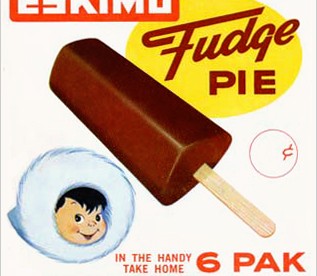The Eskimos That Saved An Economy

Ice cream is a fantastic treat which has delighted children and adults for generations. But it really took off in the United States in the 1920s, in part because of Prohibition. Many bars, now unable to pour beer from their taps, retrofitted their equipment to sell soda instead. As at-home refrigeration was still rare (it wouldn’t pass the 50% threshold until the next decade), these soda shops were also able to keep ice cream in stock, and ice cream sodas became a common sign of the times.
The American love affair with ice cream brought many confectionary innovations to market — such as the chocolate-covered ice cream bar now known as the Eskimo Pie, and seen below. As Wikipedia recounts, the Eskimo Pie was invented in 1921 by a candy shop owner named Christian Kent Nelson. Nelson noticed that his adolescent customers had trouble deciding between buying a candy bar or ice cream treat. He did a little research and figured out how to combine the two, by coating an ice cream bar in a layer of hardened chocolate. Nelson named it “I-Scream,” and patented the product. The product — renamed “Eskimo Pie” on the suggestion of its licensee, the Russell Stover corporation — was a huge hit. As the Chicago Tribune later reported, “by late 1921, 90 percent of the ice cream manufacturers in Iowa had franchises to make it. And by the spring of 1922, sales were averaging 1 million pies a day.”

But Nelson wasn’t the only beneficiary of his invention — and for that matter, neither were the very happy American ice cream purchasers. So were the the roughly 1.5 million people living in Ecuador at the time.
Ecuador has been an independent nation since 1830, but for almost a century, it was an agrarian nation without a cash crop and, as such, failed to thrive. But the Eskimo Pie changed that. If you want to make an Eskimo Pie, you need more than just ice cream — you also need chocolate. If you want to make chocolate, you’ll need cocoa beans. And at the time, Ecuador was one of the world’s largest exporters. That was a boon for the struggling nation; according to the book “Everybody Loves Ice Cream: The Whole Scoop on America’s Favorite Treat,” demand for cocoa beans skyrocketed due to the popularity of the Eskimo Bar — and therefore, so did prices. Per the book, the Eskimo Bar and similar treats “reportedly caused the price of cocoa beans to rise 50 percent and single-handedly lifted the economy of Ecuador out of depression.”
Unfortunately for Ecuador, the love affair with chocolate-covered ice cream wasn’t enough — or long enough — to give the country a multi-generation boost. As Wikipedia explains, “decline of the cacao industry in the 1930s and 1940s, brought about by chronic pestilence and the loss of foreign markets to competitors, had debilitating repercussions for the entire economy” and “by the early 1950s bananas had replaced cocoa beans as the country’s primary export crop.”
Bonus fact: The popularity of Eskimo Bars had an impact on culture which is still felt today — we just forgot about the part that involves Eskimo Bars. You’ve almost certainly heard the phrase “I scream, you scream, we all scream for ice cream!,” but you probably didn’t know that the slogan was originally the title of a song. The song dates back to 1927, and if you read the full lyrics (available here), you’ll see that it refers to a college near the Eskimos and to students who sing an Eskimo song. And, per the lyrics, the leader of the cheer has “a frozen face just like an Eskimo Pie.”
From the Archives: Ice Scream: Why we get headaches when we eat ice cream too quickly.
Take the Quiz: Can you name Baskin-Robbins’ original 31 flavors? (And: can you see the 31 hidden in their logo?)
Related: “Everybody Loves Ice Cream: The Whole Scoop on America’s Favorite Treat” by Shannon Jackson Arnold. 11 reviews, all of five stars. Does not actually come with ice cream.
